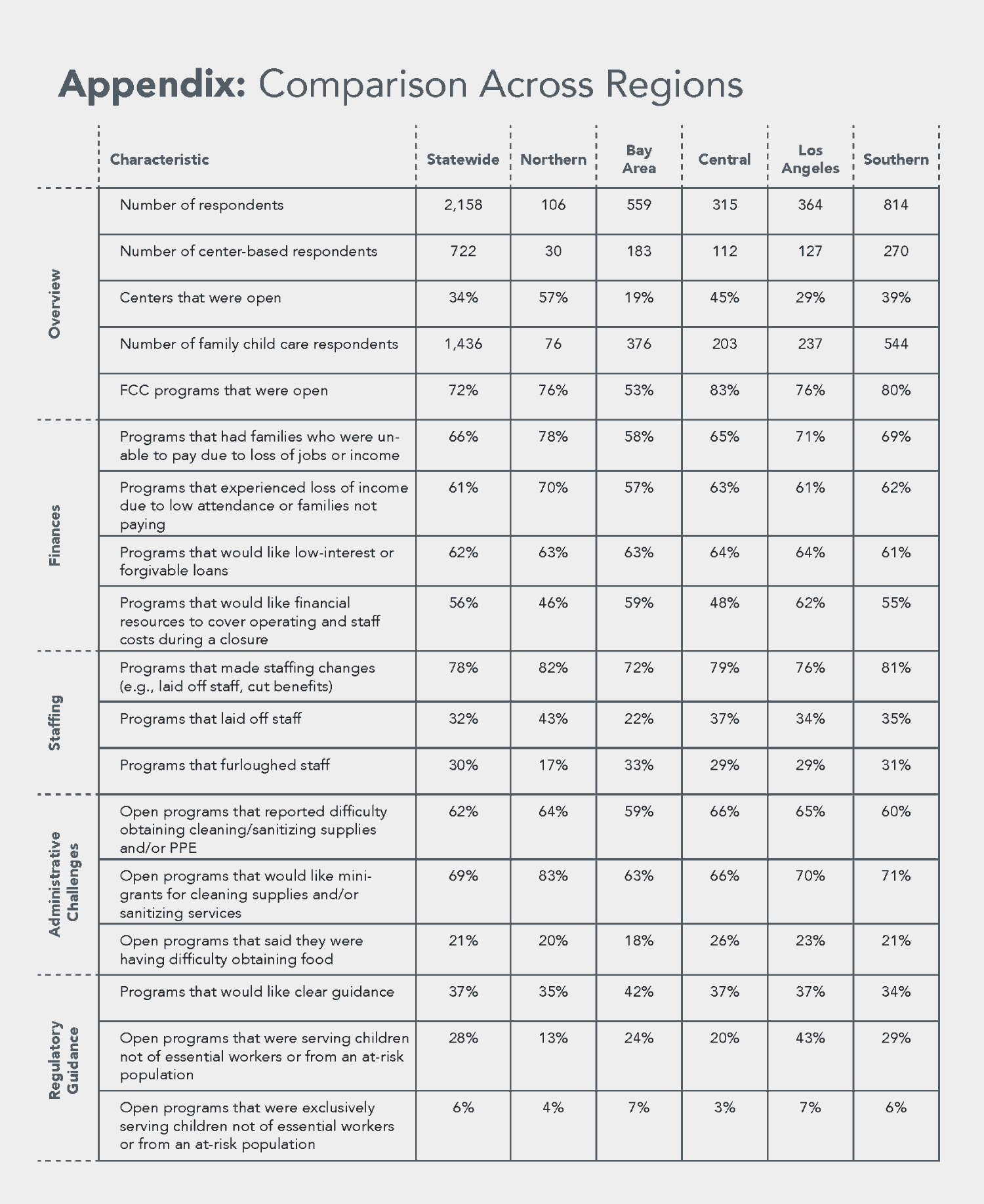Between April 13 and April 30, 2020, the Center for the Study of Child Care Employment (CSCCE) conducted a brief survey of licensed child care centers and licensed family child care (FCC) programs to understand the effects of COVID-19 on child care programs and early educators throughout California. More than 2,000 programs responded to the survey: 34 percent were centers and 66 percent were family child care programs. The statewide data and recommendations from CSCCE are summarized in the previously released California Child Care at the Brink data snapshot.
In order to understand the varied impacts of COVID-19 across geographical regions, we also analyzed the data at the regional level for five regions: Northern California, the Bay Area, Central California, Los Angeles, and Southern California. Across data points, we identified differences among regions and variations from the state average. For example, while 34 percent of centers across the state reported that they were open, in the Northern region 57 percent of centers were open and in the Bay Area 19 percent of centers were open.
For each of the five regions, we report key findings related to the fiscal, administrative, and staffing challenges programs face, as well as the need for clear regulatory guidance. The survey was voluntary and shared by word of mouth; respondents in each region may not be representative of the regional population. However, the distribution of respondents by program type and region in the sample approximated the distribution in the population of child care programs across the state.
California Regions
The 2,158 programs that responded to our survey are located throughout California. For regional analysis, we divided the state into the five regions represented here, each comprised of one or more counties, as indicated below. In some cases, we did not receive any responses from programs in a given county—those counties are indicated with italicized names below.
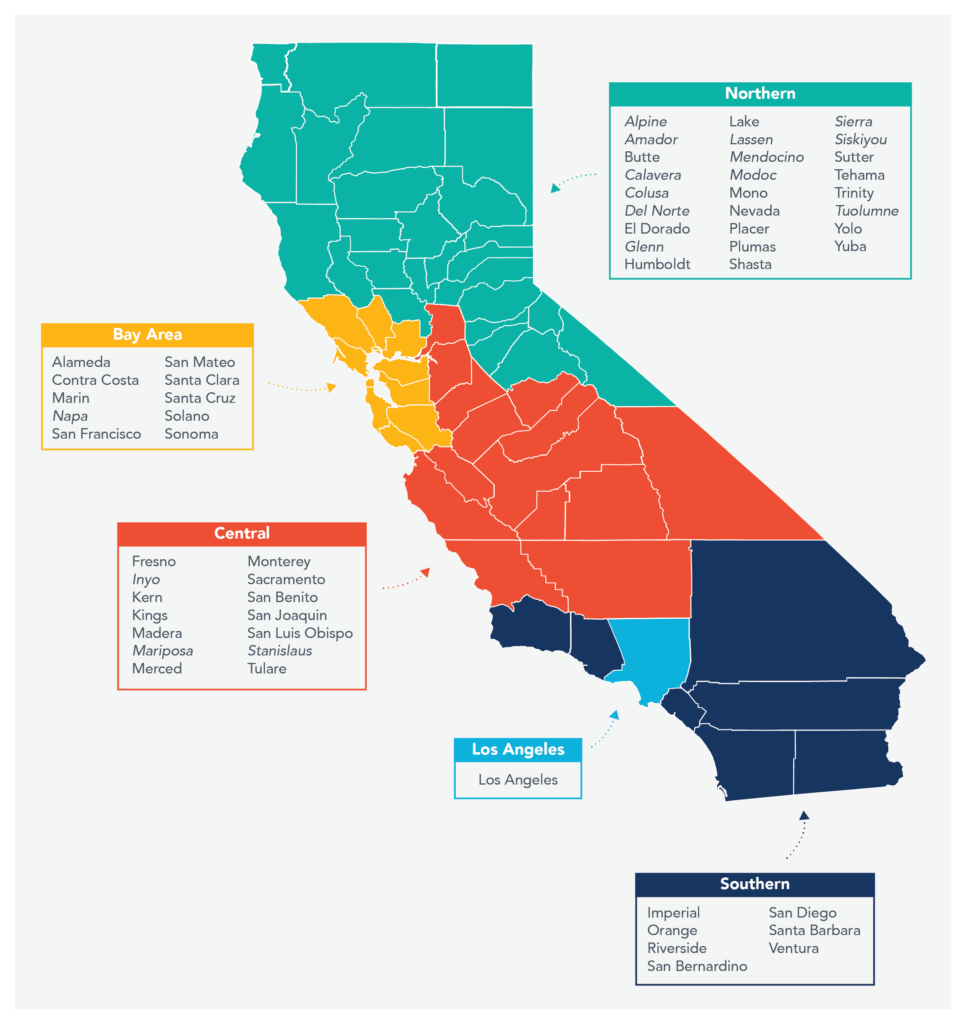
Northern California
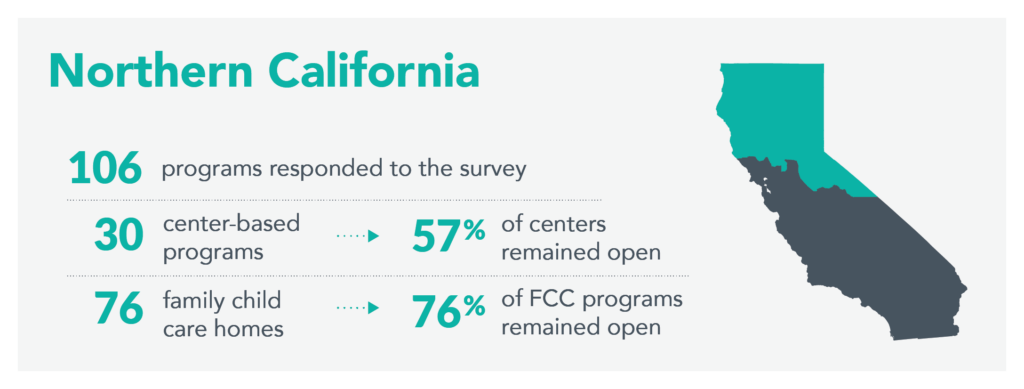
Finances
Financial Challenges
- 78% of all programs reported that they had families who were unable to pay due to loss of jobs or income
- 70% of all programs experienced loss of income due to low attendance or families not paying
Financial Support
- 63% of all programs indicated that they would like low-interest or forgivable loans
- 46% of all programs indicated that they would like financial resources to cover operating and staff costs during a closure
Staffing Changes
- 82% of all programs made staffing changes (e.g., laid off staff, cut benefits)
- 43% of all programs laid off staff
- 17% of all programs furloughed staff
Administrative Challenges
- 64% of open programs reported difficulty obtaining cleaning or sanitizing supplies and/or personal protective equipment (PPE) for staff
- 83% of open programs indicated that they would like mini-grants for cleaning supplies and/or sanitizing services
- 20% of open programs indicated that they were having difficulty obtaining food for their program
Regulatory Guidance
- 35% of all programs reported that they would like clear guidance on regulatory changes (e.g., closures, social distancing, ratios)
- 13% of open programs were still serving children who were not from families of essential workers and not from an at-risk population
- 4% of open programs were exclusively serving children who were not from families of essential workers and not from an at-risk population
Bay Area
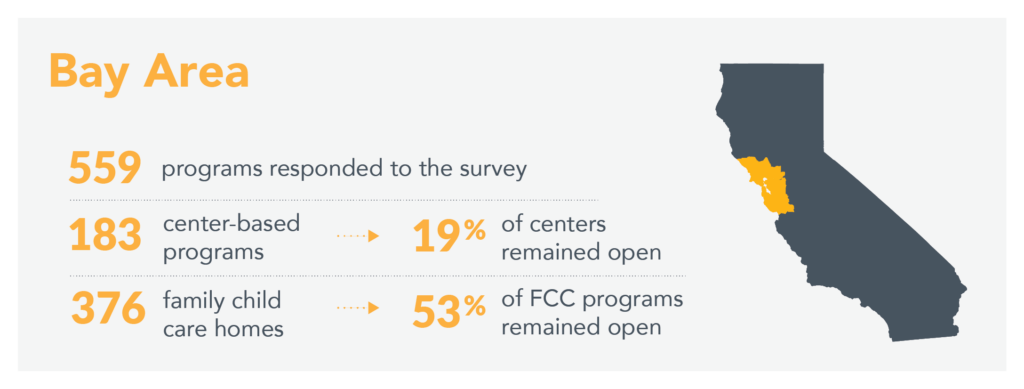
Finances
Financial Challenges
- 58% of all programs reported that they had families who were unable to pay due to loss
of jobs or income
o 57% of all programs experienced loss of income due to low attendance or families not
paying
Financial Support
- 63% of all programs indicated that they would like low-interest or forgivable loans
- 59% of all programs indicated that they would like financial resources to cover
operating and staff costs during a closure
Staffing Changes
- 72% of all programs made staffing changes (e.g., laid off staff, cut benefits)
- 22% of all programs laid off staff
- 33% of all programs furloughed staff
Administrative Challenges
- 59% of open programs reported difficulty obtaining cleaning or sanitizing supplies
and/or personal protective equipment (PPE) for staff - 63% of open programs indicated that they would like mini-grants for cleaning supplies
and/or sanitizing services - 18% of open programs indicated that they were having difficulty obtaining food for
their program
Regulatory Guidance
- 42% of all programs reported that they would like clear guidance on regulatory changes
(e.g., closures, social distancing, ratios) - 24% of open programs were still serving children who were not from families of
essential workers and not from an at-risk population - 4% of open programs were exclusively serving children who were not from families of
essential workers and not from an at-risk population
Central California
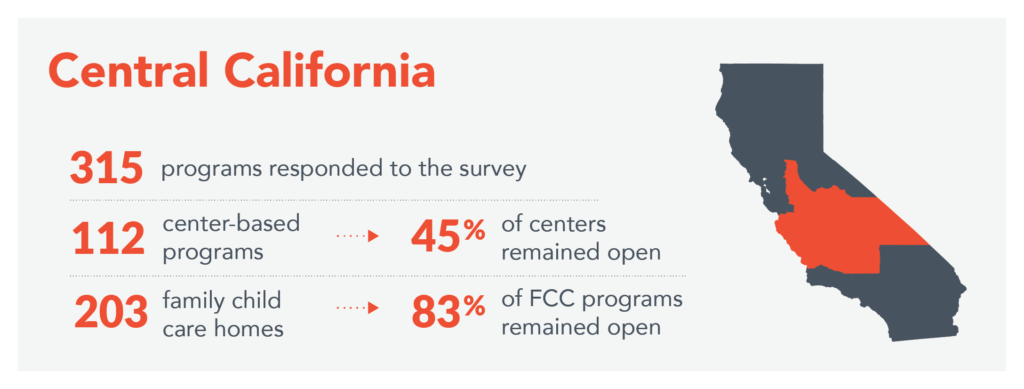
Finances
Financial Challenges
- 65% of all programs reported that they had families who were unable to pay due to loss
of jobs or income - 63% of all programs experienced loss of income due to low attendance or families not
paying
Financial Support
- 64% of all programs indicated that they would like low-interest or forgivable loans
- 48% of all programs indicated that they would like financial resources to cover
operating and staff costs during a closure
Staffing Changes
- 79% of all programs made staffing changes (e.g., laid off staff, cut benefits)
- 37% of all programs laid off staff
- 29% of all programs furloughed staff
Administrative Challenges
- 66% of open programs reported difficulty obtaining cleaning or sanitizing supplies
and/or personal protective equipment (PPE) for staff - 66% of open programs indicated that they would like mini-grants for cleaning supplies
and/or sanitizing services - 26% of open programs indicated that they were having difficulty obtaining food for
their program
Regulatory Guidance
- 37% of all programs reported that they would like clear guidance on regulatory changes
(e.g., closures, social distancing, ratios) - 20% of open programs were still serving children who were not from families of
essential workers and not from an at-risk population - 3% of open programs were exclusively serving children who were not from families of
essential workers and not from an at-risk population
Los Angeles
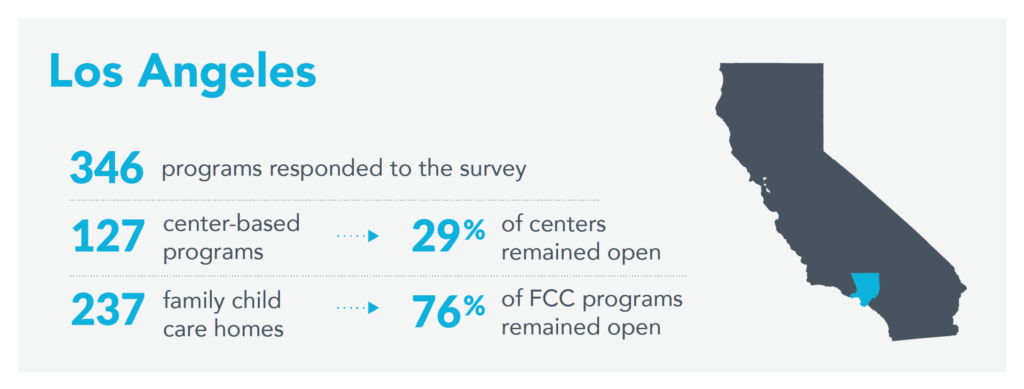
Finances
Financial Challenges
- 71% of all programs reported that they had families who were unable to pay due to loss
of jobs or income - 61% of all programs experienced loss of income due to low attendance or families not
paying
Financial Support
- 64% of all programs indicated that they would like low-interest or forgivable loans
- 62% of all programs indicated that they would like financial resources to cover
operating and staff costs during a closure
Staffing Changes
- 76% of all programs made staffing changes (e.g., laid off staff, cut benefits)
- 34% of all programs laid off staff
- 29% of all programs furloughed staff
Administrative Challenges
- 65% of open programs reported difficulty obtaining cleaning or sanitizing supplies
and/or personal protective equipment (PPE) for staff - 70% of open programs indicated that they would like mini-grants for cleaning supplies
and/or sanitizing services - 23% of open programs indicated that they were having difficulty obtaining food for
their program
Regulatory Guidance
- 37% of all programs reported that they would like clear guidance on regulatory changes
(e.g., closures, social distancing, ratios) - 43% of open programs were still serving children who were not from families of
essential workers and not from an at-risk population - 7% of open programs were exclusively serving children who were not from families of
essential workers and not from an at-risk population
Southern California

Finances
Financial Challenges
- 69% of all programs reported that they had families who were unable to pay due to loss
of jobs or income - 62% of all programs experienced loss of income due to low attendance or families not
paying
Financial Support
- 61% of all programs indicated that they would like low-interest or forgivable loans
- 55% of all programs indicated that they would like financial resources to cover
operating and staff costs during a closure
Staffing Changes
- 81% of all programs made staffing changes (e.g., laid off staff, cut benefits)
- 35% of all programs laid off staff
- 31% of all programs furloughed staff
Administrative Challenges
- 60% of open programs reported difficulty obtaining cleaning or sanitizing supplies
and/or personal protective equipment (PPE) for staff - 71% of open programs indicated that they would like mini-grants for cleaning supplies
and/or sanitizing services - 21% of open programs indicated that they were having difficulty obtaining food for their program
Regulatory Guidance
- 34% of all programs reported that they would like clear guidance on regulatory changes
(e.g., closures, social distancing, ratios) - 29% of open programs were still serving children who were not from families of
essential workers and not from an at-risk population - 6% of open programs were exclusively serving children who were not from families of essential workers and not from an at-risk population
